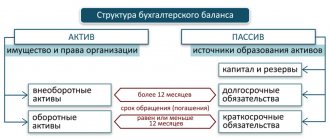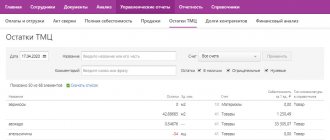What are cash and cash equivalents?
Cash and cash equivalents include all cash and highly liquid assets with short maturities (typically 90 days or 3 months). This item is always classified as current assets on line 1250 of the balance sheet.
Take our proprietary course on choosing stocks on the stock market → training course
Cash equivalents include bank accounts and marketable securities, which are debt securities with maturities of less than 90 days.
However, cash equivalents often do not include shares or shareholdings because they can fluctuate in value.
Examples of cash equivalents include commercial paper, Treasury bills, and short-term government bonds with maturities of three months or less. Marketable securities and money market assets are considered cash equivalents because they are liquid and not subject to significant fluctuations in value.
Decoding lines for balance sheet liabilities
| Dt 10 + Dt 11 – Kt 14 + Dt 15 + Dt 16 + Dt 20 + Dt 21 + Dt 23 + Dt 28 + Dt 29 + Dt 41 – Kt 42 + Dt 43 + Dt 44 + Dt 45 + Dt 97 (in part expenses with a write-off period of no more than 12 months after the reporting date) | |||
| Value added tax on purchased assets | 1220 | 19 “Value added tax on acquired assets” | Dt 19 |
| Accounts receivable | 1230 | 46 “Completed stages of work in progress”, 60 “Settlements with suppliers and contractors”, 62 “Settlements with buyers and customers”, 63 “Provisions for doubtful debts”, 68 “Settlements for taxes and duties”, 69 “Settlements for social insurance and security", 70 "Settlements with personnel for wages", 71 "Settlements with accountable persons", 73 "Settlements with personnel for other operations", 75 "Settlements with founders", 76 "Settlements with various debtors and creditors" | Dt 46 + Dt 60 + Dt 62 – Kt 63 + Dt 68 + Dt 69 + Dt 70 + Dt 71 + Dt 73 (except for interest-bearing loans accounted for in subaccount 73-1) + Dt 75 + Dt 76 (less reflected in accounts for VAT calculations on advances issued and received) |
| Financial investments (excluding cash equivalents) | 1240 | 58, 55-3, 59, 73-1 | Dt 58 – Kt 59 (in terms of short-term financial investments) + Dt 55-3 + Dt 73-1 (in terms of short-term interest-bearing loans) |
| Cash and cash equivalents | 1250 | 50 “Cash”, 51 “Current accounts”, 52 “Currency accounts”, 55 “Special bank accounts”, 57 “Transfers in transit”, | Dt 50 (except for subaccount 50-3) + Dt 51 + Dt 52 + Dt 55 (except for the balance of subaccount 55-3) + Dt 57 |
| Other current assets | 1260 | 50-3 “Money documents”, 94 “Shortages and losses from damage to valuables” | Dt 50-3 + Dt 94 |
| Index | Code | Which account data does it use? | Algorithm for calculating the indicator |
| Authorized capital (share capital, authorized capital, contributions of partners) | 1310 | 80 “Authorized capital” | Kt 80 |
| Own shares purchased from shareholders | 1320 | 81 “Own shares (shares)” | Dt 81 (in parentheses) |
| Revaluation of non-current assets | 1340 | 83 “Additional capital” | Kt 83 (regarding the amounts of additional valuation of non-current assets) |
| Additional capital (without revaluation) | 1350 | 83 | Kt 83 (except for amounts of additional valuation of non-current assets) |
| Reserve capital | 1360 | 82 “Reserve capital” | Kt 82 |
| Retained earnings (uncovered loss) | 1370 | 99 “Profits and losses”, 84 “Retained earnings (uncovered loss)” | Or Kt 99 + Kt 84 |
Or Dt 99 + Dt 84 (the result is reflected in parentheses)
Or Kt 84 - Dt 99 (if the value is negative, it is reflected in parentheses)
Or Kt 99 - Dt 84 (same)
If you find an error, please select a piece of text and press Ctrl+Enter.
Concept and understanding of the category
Cash and cash equivalents are a group of assets owned by a company. For ease of understanding, this is the total value of cash on hand and cash-like assets. If a company has cash or cash equivalents, the totality of these assets is always shown on the top line of the balance sheet. This is because cash and cash equivalents are current assets, which means they are the most liquid of the short-term balance sheet items.
Important! Companies with significant amounts of cash and cash equivalents may have a positive view of their ability to meet short-term debt obligations.
Difference between cash and cash equivalents
The key differences are presented in the table below.
| View | Characteristics and distinctive features |
| Cash | Cash in the form of currency. They include all bills, coins and banknotes. |
| Cash equivalents | For an investment to qualify as equivalent, it must be readily convertible into cash and be subject to negligible value risk. Therefore, an investment usually qualifies as a cash equivalent only if it has a short maturity, say three months or less. |
The importance of using these categories
There are several main reasons why these categories are significant. They are reflected in the table below.
| No. | Cause | Characteristics and description | Clarification |
| Source of liquidity | Cash equivalents are held to satisfy short-term cash obligations and not for investment or other purposes and are an important source of liquidity. Thus, companies want to have a cash cushion to withstand unforeseen situations such as revenue shortfalls, equipment repairs or replacements, or other unforeseen circumstances not budgeted for. | Liquidity ratio calculations are important in determining the rate at which a company can pay off its short-term debt. Various options for liquidity ratios include: total liquidity ratio, current ratio, quick ratio. Total liquidity ratio: (cash and cash equivalents + marketable securities) ÷ current liabilities Current ratio: current assets ÷ current liabilities. Quick ratio: (Current asset - stock) ÷ Current liabilities. | |
| Speculative acquisition strategy | Another good reason for saving is an acquisition in the near future. | As an example, consider the cash balance on Apple Inc's balance sheet: · Cash = $13.844 billion · Total assets = $231.839 billion Cash as % of total assets = 13,844 / 231,839 ~ 6% · Total sales in 2014 = $182,795 Cash as % of Total Sales = 13,844 / 182,795 ~ 7.5% Investments of $13.844 billion (cash) + $11.233 billion (short-term investments) + $130.162 billion (long-term investments) amount to $155.2 billion. The combination of all this indicates that Apple may be looking for some kind of acquisition in the near future. |
Pros and cons of availability
Positive aspects of having:
- maturity and ease of conversion. They are beneficial from a business perspective because a company can use them to meet any short-term needs;
- financial repository. Retained equity is a way of storing money until a business decides what to do with it.
Negative aspects of having:
- loss of income: sometimes companies set aside an amount in equivalents that exceeds the amount needed to cover immediate obligations, depending on market conditions. When this happens, the company loses potential income because money that could have generated higher profits elsewhere has been transferred to a cash account;
- low yield: many equivalents have yield. However, the interest rate is usually low. A low interest rate makes sense given that equivalents are low risk.
The most common options and types
Cash and cash equivalents help companies in meeting their working capital needs as these liquid assets are used to pay off current liabilities, which are short-term debts and bills.
Cash is money in the form of currency and includes all bills, coins and notes.
A demand deposit is a type of account from which funds can be withdrawn at any time without notifying the institution. Examples of demand deposit accounts include checking and savings accounts. All demand account balances at the date of the financial statements are included in total cash.
Foreign currency. Companies holding more than one currency conduct transactions such as currency exchange. Currency for foreign countries must be converted into reporting currency for financial purposes. The conversion must provide results comparable to those that would have occurred if the business had completed operations using only one currency. Foreign currency revaluation losses are not reflected in cash and cash equivalents. These losses are reflected in a separate document.
Cash equivalents are investments that can be easily converted into cash. Investments must be short-term, usually with a maximum duration of three months or less. If the investment period exceeds 3 months, it should be classified in an account called “other investments”. Cash equivalents must be highly liquid and easily traded in the market. Buyers of these investments must be easily accessible.
All cash equivalents must have a known market price and should not be subject to fluctuations in value. The value of cash equivalents cannot be expected to change significantly prior to maturity.
Certificates of deposit may be considered cash equivalents depending on their maturity date.
Preferred shares may be considered cash equivalent if they are purchased close to the maturity date and are not expected to fluctuate significantly in value.
Adding user accounts. Balance sheet including added accounts
CONTENT.
1) Is it worth adding a new account?
2) Adding a new account to the balance sheet.
In the accounting 3.0 configuration, as we all know, there is such an object as the “Chart of Accounts”. It contains a list of predefined accounts that are defined in the configurator.
Sometimes the accountant is asked to add additional accounts to this plan. Quite often, this situation arises during the first implementation of a configuration, when accounting is not carried out in 1C programs. Here, with 100% probability, there will be some missing accounts in the standard chart of accounts. Or they will have different names.
In general, the program has the ability to add accounts even in user mode. And here the question arises whether to follow the accountant’s lead or not. Based on my experience, I can say that in any case it is worth trying to dissuade. But it all depends on what they want to add to the account.
For example, there are accounts that are tied to specific facts of economic activity. There was a case when the accounting department took into account certain fixed assets on the account “01.09”, and as we know, the program uses this predefined account to generate transactions upon disposal of fixed assets. And in this case, I had to insist that the accounting department no longer use it to account for fixed assets.
What arguments can be used to convince accountants? Well, firstly, in most cases they use additional accounts as a kind of analytics. To somehow share the information for yourself. For example, there was a case where an accountant always used only one checking account. And then a situation arose that the organization opened another account in another bank. A request immediately arose - add us one more account (in addition to 51) so that the program can take into account banking transactions on these accounts separately. Here it was quite easy to convince that this was not necessary, since 51 accounts have a subaccount “Bank Accounts” and it would be more correct to add not a new account, but one more element to this directory.
Accordingly, the main argument is to show that the accounts have additional analytics in the form of directories. It should be used, and not added new accounts.
There is often a situation where you are asked to add additional subaccounts to account 60 or 62 in order to see summary information for groups of counterparties. This request is due to the fact that accountants do not use the settings that are available in standard reports. In the account balance sheet (ATS) for account 60 or 62, analytics are displayed by default without groups. But this is easy to change in the report settings. And in this case, it is more correct not to add additional subaccounts, but to add groups to the “Counterparties” directory. And in standard reports, set the information output to “With groups” in the settings.
The situation is a little more complicated when the account settings do not contain the necessary analytics. For example, there was a situation when an accountant wanted to divide the information on a tax accrual account (I don’t remember exactly which one, in general, in one of the subaccounts of account 68) across several tax accounts. There is no reference book on the account as analytics, but we ourselves can add another subconto, as which we can create a reference book with the value type “Subconto” in user mode.
It turns out that in most cases you can do without adding new accounts. But if the accountant turns out to be very stubborn and he definitely needs a new account, then, in my opinion, you can add an account if it is not related to specific operations. In this case, you need to check how these operations will be processed. It will be necessary to see whether the developers took into account the fact that the user will add new accounts. For example, if you add a subaccount to an expense account 20, say 20.03, then when closing the month it will automatically close in the same way as the standard 20.01. However, if we add a new expense account (say 27, as a copy of 26), it will not be automatically closed for us.
There is one more thing to consider when adding new accounts. This is reporting that is completed based on accounting entries. For example, a regulated report “Accounting statements since 2011” or a balance sheet. It (the balance sheet) is filled out precisely according to the balances on the accounting accounts. And the filling procedure is designed only for standard accounts, and balances from our added accounts will not go into it, but in the meantime they should. Therefore, the filling procedure will have to be refined, and then done regularly, as it changes periodically.
Moreover, developers often do not change the current handler, but add a new one. Therefore, it is impossible to track this during the update. You need to check it purposefully. At the moment, in “Accounting 3.0” the filling procedures are located in the general module: Filling out Accounting Reports Main:
In principle, everything in these procedures is very simple. Here is a piece of code to which changes were made:
RowNumber = "1150"; LineName = “Fixed Assets”; IndicatorAreaName = “P000100” + LineNumber + Column; Transcript Header = “Line” + LineNumber + “””” + LineName + “””, column “”” + ColumnHeader + “”””; SKD_01 = SKD("01", Account Balance and Turnover); SKD_01_01 = SKD("01.01", BalanceAndTurnoverOnAccounts); SKD_01_03 = SKD("01.03", BalanceAndTurnoverOnAccounts); SKD_01_08 = SKD("01.08", BalanceAndTurnoverOnAccounts); SKK_02_01 = SKK ("02.01", Balance and Turnover on Accounts); SKK_02_03 = SKK("02.03", BalanceAndTurnoverOnAccounts); SKD_07 = SKD("07", Account Balance and Turnover); SKD_08_01 = SKD("08.01", BalanceAndTurnoverOnAccounts); SKD_08_02 = SKD("08.02", BalanceAndTurnoverOnAccounts); SKD_08_03 = SKD("08.03", BalanceAndTurnoverOnAccounts); SKD_08_04 = SKD("08.04", BalanceAndTurnoverOnAccounts); SKD_08_9L = SKD(Plans of Accounts. Self-supporting.FindByCode("08.9L"), BalanceAndTurnoverAccounts); SKK_02_01__01_01 = DividedAccountBalance_02_01.SKK_02_01__01_01; // Depreciation of fixed assets recorded on account 01.01 SKK_02_01__01_08 = DividedAccount Balance_02_01.SKK_02_01__01_08; // Depreciation of fixed assets recorded on account 01.08 Type of Asset RBP = Transfers. Types of Assets for RBP. Fixed Assets; SKD_97_By Type of Asset = Structure SKD_97 [Type of Asset RBP]; SKD_76_01_2_By Type of Asset = Structure SKD_76_01_2 [Type of Asset RBP]; SKD_76_01_9_By Type of Asset = Structure SKD_76_01_9 [Type of Asset RBP]; Indicator Value = SKD_01 - SKD_02_01 - SKD_02_03 + SKD_07 + SKD_08_01 + SKD_08_02 + SKD_08_03 + SKD_08_04 + SKD_97_By Type of Asset + SKD_76_01_2_By Type of Asset + SKD_76_0 1_9_By Type of Asset + SKD_08_9L; SetIndicatorValue(CalculatedIndicators, SectionName, IndicatorAreaName, IndicatorValue); AddDecryptionLine(DecryptionTable, IndicatorAreaName,DecryptionHeader, “+”, “!SKD ” + Account(“01”).Code, SKD_01, SectionName, OSVPAccountSettings(GeneralDecryptionParameters, Account(“01”))); AddDecryptionLine(DecryptionTable,IndicatorAreaName, "", "-", "!SKK" + Account("02.01").Code, -SKK_02_01, SectionName, Account Settings (GeneralDecryptionParameters, Account("02.01"))); AddDecryptionLine(DecryptionTable,IndicatorAreaName, "", "-", "!SKK" + Account("02.03").Code, -SKK_02_03, SectionName, Account Settings (GeneralDecryptionParameters, Account("02.03"))); AddDecryptionLine(DecryptionTable,IndicatorAreaName, "", "+", "!SKD " + Account("07").Code, SKD_07, SectionName, OSVPAccountSettings(GeneralDecryptionParameters, Account("07"))); AddDecryptionLine(DecryptionTable,IndicatorAreaName, "", "+", "!SKD " + Account("08.01").Code, SKD_08_01, SectionName, OSVPAccount Settings(GeneralDecryptionParameters, Account("08.01"))); AddDecryptionLine(DecryptionTable,IndicatorAreaName, "", "+", "!SKD " + Account("08.02").Code, SKD_08_02, SectionName, OSVPAccount Settings(GeneralDecryptionParameters, Account("08.02"))); AddDecryptionLine(DecryptionTable,IndicatorAreaName, "", "+", "!SKD " + Account("08.03").Code, SKD_08_03, SectionName, OSVPAccount Settings(GeneralDecryptionParameters, Account("08.03"))); AddDecryptionLine(DecryptionTable,IndicatorAreaName, "", "+", "!SKD " + Account("08.04").Code, SKD_08_04, SectionName, OSVPAccount Settings(GeneralDecryptionParameters, Account("08.04"))); Add Decryption Row(Decryption Table, Indicator Area Name, "", "+", "! SKD " + Account Plans. Self-supporting. Find By Code("08.9L"). Code, SKD_08_9L, Section Name, Account Settings (General ParametersDecryption, Accounting Plans. Self-supporting. Find By Code("08.9L" ))); SelectionByAnalytics = New Match;
“1150” is the balance line where information on the new user account “08.9L” will be added.
For this, a variable was declared where we get the final credit balance on our account:
SKD_08_9L = SKD(Plans of Accounts. Self-supporting.FindByCode("08.9L"), BalanceAndTurnoverAccounts);
Next, this balance was added to the “Indicator value” variable, in which we have the value displayed in the “1150” line of the balance sheet.
Well, for the convenience of viewing by the user the components of the value of the line “1150”, a decryption was added:
AddDecryptionLine(DecryptionTable, IndicatorAreaName, “”, “+”, “! SKD " + Charts of Accounts. Self-supporting. Find By Code ("08.9L"). Code, SKD_08_9L, SectionName, OSVPAccount Settings(GeneralDecryptionParameters,AccountPlans.Cost Accounting.FindByCode("08.9L")));
What cash and equivalents do not include
There are some exceptions for current assets and current assets classified as cash and cash equivalents.
Credit collateral. Exceptions may exist for short-term debt instruments such as Treasury bills if they are used as collateral for an outstanding loan or line of credit. Prohibited T-bills must be identified separately. In other words, there may be no restrictions on the conversion of any of the securities listed as cash and cash equivalents.
Inventories. The inventory that a company has in stock is not considered cash equivalent because it cannot be easily converted into cash. In addition, the value of inventory is not guaranteed, meaning there is no certainty as to the amount that will be received for the liquidation of these assets.
Rules and requirements for filling out a cash flow statement
- Receipts from the sale of goods, fixed assets and other things are shown without VAT. Payments to suppliers and contractors are also reflected without VAT.
- VAT and excise taxes are indicated separately, in collapsed form, as part of cash flows from current operations. All VAT (excise taxes) presented to customers is taken and compared with the amount of all input VAT (excise taxes). If the tax presented is greater than the input tax, the difference is shown in line 4119 “Other income”. If less, then on line 4129 “Other payments”.
- Salaries issued (including personal income tax) and insurance premiums paid are reflected in line 4122 “In connection with remuneration of employees.”
- Income tax is shown separately in line 4124 “Organizational income tax.” Other taxes (except for VAT, excise taxes and personal income tax) are summed up and reflected in a line specially entered for this purpose - for example, 4125 “Other taxes and fees”.
Prepare financial statements and submit them to the Federal Tax Service via the Internet Submit for free
Calculation example
Example No. 1. For example, suppose that the opening balance of the cash account was 10,000 rubles, the total amount of debits for the year was 15,000 rubles, and the total amount of credits for the year was 8,000 rubles.
Let's add each account's total debit to its opening balance. For example, let's add 15,000 tr. to the total amount of debits to the initial balance on the cash account of 10,000 tr., which is equal to 25,000 tr.
We subtract the total number of credits of each account from each result to calculate the year-end balance for each account.
For example, we subtract 8,000 rubles. in the total amount of loans on the cash account from the result of 25,000 tr. This equals a final cash balance of 17,000 rubles.
We will calculate the ending balance of each account to determine the balance at the end of the year in cash and cash equivalents.
For example, if the year-end balances for cash, wages, petty cash investments and money market investments are respectively 17,000, 5,000, 1,000 and 4,000 TR, then their amount should be calculated. It is equal to 27,000 tr. as the balance of cash and cash equivalents at the end of the year.
Indicate the balance of cash and cash equivalents at the end of the year in line 1250 of the balance sheet in the current assets section.
Structure and content of the cash flow statement
The report form was approved by order of the Ministry of Finance dated July 2, 2010 No. 66n. The rules for drawing up are established by PBU 23/2011 “Cash Flow Statement”.
The report has three sections.
The first reflects cash flows from current operations. These are revenues and payments from the ordinary activities of the organization. Based on the results of such operations, as a rule, profit (loss) from sales is formed.
The second reflects cash flows from investment operations. These include the purchase and sale of vehicles, equipment, etc. Another example is financial investments other than the purchase of cash equivalents and investments intended for resale in the short term.
The third section shows flows from financial transactions. These are contributions from the founders, proceeds from the issue of shares, bank loans, etc.
Check the financial condition of your organization and its counterparties
What can increase cash on the balance sheet?
Companies can increase cash through increased sales, collection of overdue accounts, control of expenses, and financing and investment. These options are reflected in the table below.
| Growth option | Characteristic |
| Sales growth | Increased sales usually mean higher levels of cash on the balance sheet. When a company makes a cash sale, the accounts must increase the sales account on the income statement and the cash account on the balance sheet. When it receives cash payments on credit accounts, the company converts the amounts from accounts receivable to cash. Innovative and quality products, targeted marketing and superior customer service are some of the ways to consistently achieve higher sales and gain a competitive advantage in the market. |
| Accounts receivable management | Some sales are cash and others are on credit. The accounts receivable balance in the current assets section of the balance sheet contains outstanding credit accounts. Although a business may receive most payments during the billing period, some bills are past due while others are not due for collection. More stringent credit control procedures, such as reducing credit limits for customers who have fallen behind in the past or waiving loans to customers experiencing financial difficulties, can reduce the number of overdue accounts and increase cash flow. Sending automatic email reminders, following up with overdue customers, and offering discounts for early payment of invoices are some of the other ways to manage accounts receivable and increase cash on your balance sheet. |
| Cost control | Controlling expenses increases cash levels. Sales growth is an important but not sufficient condition for increasing cash flow. For example, if a five percent increase in sales requires a seven percent increase in marketing spending, cash levels may actually decrease rather than increase. Companies incur variable costs such as direct labor and raw materials. The companies also recorded overhead costs such as administrative staff salaries and advertising. Negotiating better terms with suppliers and adjusting production shifts to accommodate rising or falling demand are ways to manage variable costs. Streamlining business processes, reducing travel, and using contractors instead of in-house employees are some ways to reduce overhead costs. |
| Financing and investment activities | Companies can increase cash levels through financing and investing. Financing activities include proceeds from bank loans and from issuing shares or bonds to investors. For small businesses that may not have easy access to financial markets, an infusion of cash from founding partners, venture capitalists and angel investors will increase cash on the balance sheet. Paying dividends and interest from investments in stocks and bonds also increases cash levels. Selling excess capital investments, such as regional offices, distribution centers, excess equipment or unused vehicles, increases cash on the balance sheet. |
| Other | Other ways to increase cash include selling investments in subsidiaries or spinning off business units. |
Who must submit a balance sheet?
The balance sheet is one of the financial reporting forms.
The legislation establishes that all legal entities, regardless of their organizational form and the applicable taxation regime, must prepare and submit reports to tax and statistical authorities. This obligation also applies to non-profit organizations and bar associations. Balance sheets and profit and loss statements do not have to be submitted only to entrepreneurs, as well as branches of foreign companies. But they can do this on their own initiative.
Attention! Previously, some organizations were exempt from preparing a balance sheet, but currently such provisions are no longer in effect. Business entities classified as small businesses are given the right to submit reports in a simplified form. It includes a balance sheet in Form 1 and a statement of financial results in Form 2, so enterprises must send it to regulatory authorities.
FAQ
Question No. 1. What is included in cash?
Answer. These include such means as:
- money;
- currency;
- cash in current accounts;
- cash in savings accounts;
- bank amounts;
- Money transfers.
Question No. 2. What is considered cash equivalents?
Answer:
Answer. These include such means as:
- short-term government bonds;
- bills;
- securities;
- money market funds;
- treasury bonds.
Question No. 3. What are the main criteria for classifying cash and cash equivalents?
Answer. The two main criteria for classification as a cash equivalent are that:
- the asset can be easily converted into a known amount of cash;
- it must be so close to the maturity date that there is little risk of changes in value due to changes in interest rates at the time of maturity.
Question No. 4. In what situations is cash and cash equivalents analysis used?
Answer. Information about cash and cash equivalents is sometimes used by analysts in comparison to a firm's current liabilities to assess its ability to pay its bills in the short term. However, this analysis may be flawed if there are accounts receivable that can be easily converted into cash within a few days.
Question No. 5. What is included in cash?
Answer. In economic terms, cash is the form of exchange for all business transactions and activities of a company. In other words, it is a standard payment method for businesses. This is a banknote that is legal tender for all public and private debts.
Question #6 : Are certificates of deposit included in this category?
Answer. Yes, certificates of deposit are short-term securities that are easily converted into a known amount of money in a short period of time. Certificates of deposit are always included in cash equivalents.
Cash equivalents
Info Cash is what all organizations involved in the sale of goods and services carry out their activities for.
Making a profit is the main goal of any business company in market conditions. All market participants must pay taxes on the money received to the state. And to accurately calculate these amounts, accurate accounting and reporting is necessary. For these purposes, there are many forms of reporting documents, one of which is the balance sheet. This article discusses issues such as types of funds in the balance sheet, cash in cash and non-cash forms, their equivalents, accounting accounts, rows in the table, as well as analysis tasks. A few words about the balance sheet The balance sheet is the most important reporting document of an organization. The approaches used by the organization to separate cash equivalents from other financial investments are enshrined in its accounting policies (clause 23 of PBU 23/2011). Attention! Instructions for using the Chart of Accounts subaccount 55-3 “Deposit accounts” are intended for accounting for funds invested by the organization in bank and other deposits. But since these deposits, as a rule, satisfy the criteria for their recognition as financial investments (clauses 2, 3 of PBU 19/02), their accounting can be kept in account 58 “Financial investments”. Regardless of the account in which deposits are accounted for in accounting, in the Balance Sheet they must be shown as part of financial investments either on line 1170 or line 1240 (depending on the circulation (repayment) period) (clause 41 of PBU 19/02 ).






